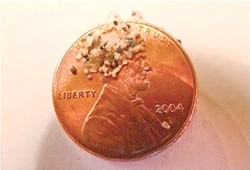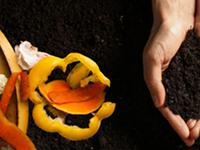Tuesday, September 15, 2015
Dems want Monroe County to ban the beads
Posted By Jeremy Moule on Tue, Sep 15, 2015 at 12:23 PM
Democrats in the Monroe County Legislature want to ban the sale of personal care products containing microbeads within Monroe County.
Legislator Dorothy Styk of Perinton introduced the legislation, which will be considered by the Legislature's Agenda/Charter Committee on September 30. Erie County has passed similar legislation, and Albany and Chautauqua counties are considering bans of their own.
The State Assembly passed legislation to ban the beads this year, and had passed a similar bill last year. But both times Republican leaders in the State Senate failed to bring the bill up for a vote, despite broad bipartisan support. Styk says that, in absence of state or federal action, the county needs to send a message.
"We can't wait for the state or federal government to act," she said during a press conference this morning.
But Styk's referral is unlikely to make it through the committee. Republican legislators have said they want to see federal action, since Monroe is only one county within the Great Lakes system. (The GOP's Legislature office hasn't yet responded to a request for comment.)
Microbeads are tiny plastic particles used in face washes, hand soaps, shampoos, and toothpastes, among other products. Waste water treatment plants, including Monroe County's Van Lare facility, can't trap the beads because they're too small. As a result, the beads are discharged into water bodies.
Researchers have identified significant levels of beads in the Great Lakes, with Lake Ontario having the highest concentration. They've also found that the beads absorb pollutants from the aquatic environment, including PCB's and DDT. Fish and other aquatic organisms eat the beads, which they mistake for food. When the organisms ingest the beads, they absorb the pollutants, which then enter marine food webs.
Legislator Dorothy Styk of Perinton introduced the legislation, which will be considered by the Legislature's Agenda/Charter Committee on September 30. Erie County has passed similar legislation, and Albany and Chautauqua counties are considering bans of their own.
The State Assembly passed legislation to ban the beads this year, and had passed a similar bill last year. But both times Republican leaders in the State Senate failed to bring the bill up for a vote, despite broad bipartisan support. Styk says that, in absence of state or federal action, the county needs to send a message.
"We can't wait for the state or federal government to act," she said during a press conference this morning.
But Styk's referral is unlikely to make it through the committee. Republican legislators have said they want to see federal action, since Monroe is only one county within the Great Lakes system. (The GOP's Legislature office hasn't yet responded to a request for comment.)
Microbeads are tiny plastic particles used in face washes, hand soaps, shampoos, and toothpastes, among other products. Waste water treatment plants, including Monroe County's Van Lare facility, can't trap the beads because they're too small. As a result, the beads are discharged into water bodies.
Researchers have identified significant levels of beads in the Great Lakes, with Lake Ontario having the highest concentration. They've also found that the beads absorb pollutants from the aquatic environment, including PCB's and DDT. Fish and other aquatic organisms eat the beads, which they mistake for food. When the organisms ingest the beads, they absorb the pollutants, which then enter marine food webs.






